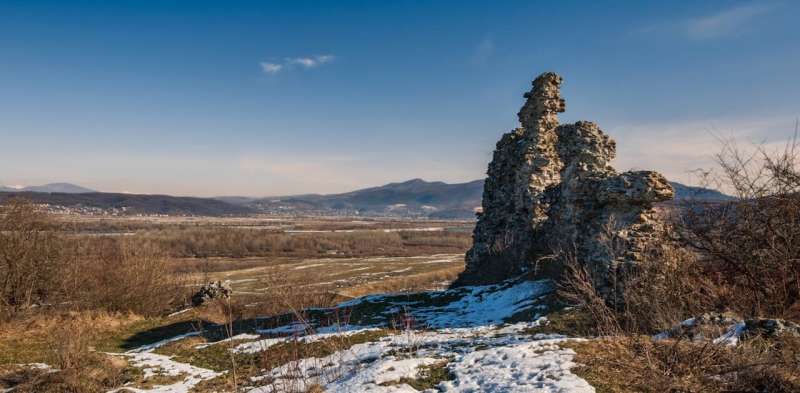This article has been reviewed according to Science X's editorial process and policies. Editors have highlighted the following attributes while ensuring the content's credibility:
fact-checked
peer-reviewed publication
trusted source
written by researcher(s)
proofread
The first Europeans reached Ukraine 1.4 million years ago, new study finds

During warm periods in Earth's history, known as interglacials, glaciers the size of continents pulled back to reveal new landscapes. These were new worlds for early humans to explore and exploit, and 1.4 million years ago this was Europe: a Terra nullius unoccupied by humans.
Long before it emerged as the epicenter of global colonialism, Europe was itself colonized for the first time by humans migrating from the east.
A new study, led by a team from the Czech Academy of Sciences and Aarhus University and published this week in Nature, reports the earliest human presence in Europe, at a site on the Tysa River in western Ukraine known as Korolevo.
Buried stone tools at Korolevo, Ukraine
We studied a layer of stone tools left on a river bed by the people who crafted them. These "core-and-flake" tools were made in the Oldowan style, the most primitive form of tool-making, first classified by the palaeoanthropologist Mary Leakey in east Africa. Similar tools have also been found at the oldest known sites of human occupation in Europe, the Levant, and Asia.
The tools at Korolevo had been buried by river sediment and later by wind-blown dust, and then eventually uncovered by workers at a stone quarry. Evidence of prehistoric people at this site was first discovered in 1974 by the Ukrainian archaeologist, V. N. Gladilin.
Early efforts to date the tools proved troublesome. Measurements of remnant magnetism in the overlying sediments indicated that the lowermost tools predate the most recent reversal in the Earth's magnetic field 0.8 million years ago, an event known as the Matuyama-Brunhes reversal. This timing is well beyond the limits of commonly used dating methods, such as radiocarbon (useful back to about 50 thousand years) and luminescence dating (usually limited to the last 300 thousand years or so).
A dating method based on cosmic rays
To solve this problem, we applied an innovative dating method using cosmogenic nuclides that can reach back 5 million years, the critical timeframe for human evolution. This method has already yielded definitive ages at other key sites, such as the 3.4 million year old Australopithecus at Sterkfontein in southern Africa, and the 0.77 million year old Zhoukoudian Homo erectus, also known as "Peking Man."
It works like this: exploding stars (supernovae) outside our solar system release streams of cosmic rays that enter Earth's upper atmosphere, sending showers of secondary cosmic rays down to Earth, where they react with minerals in rocks and soils to produce radioactive nuclides in tiny but measurable quantities.
We measured two such nuclides, beryllium-10 and aluminum-26, to calculate the burial age. A date was obtained by observing the ratio of these two nuclides, which changes over time during burial due to their differing radioactive decay half-lives: 1.4-million-years for beryllium-10 and 0.7-million-years for aluminum-26.
By applying this approach to the sediment layer containing the stone tools at Korolevo, we were able to calculate a burial age of 1.5 to 1.3 million years (the 1-sigma uncertainty range), making this Europe's earliest securely dated human occupation.

Who lived at Korolevo?
The absence of fossils at Korolevo means we cannot definitively say who these pioneers were. However, the tools are too old and too primitive to be the work of either anatomically modern humans (Homo sapiens), or Neanderthals. The tool makers were likely some variety of Homo erectus, a remarkably successful ancestor of humans that appeared around 2 million years ago, and spread across diverse habitats in Africa, Asia, and Europe.
On their journey from Africa into Eurasia, early humans passed through the Levant region, where they left signs of occupation as early as 2.5 million years ago at Zarqa Valley. Further north, numerous Homo erectus fossils have been found at Dmanisi in the Caucasus Mountains, dating to 1.8 million years ago.
Europe colonized from the east
Once into Eurasia, people migrated eastward at a remarkable pace, reaching as far as the island of Java, southeast Asia, by around the same time we find them in western Ukraine. It is not known what caused the delayed westward incursion into Europe, but it appears that Korolevo bridges the migration gap between the Caucasus (1.8 million years ago) and sites in southwestern Europe dated to 1.2 to 1.1 million years at Atapuerca and Vallonnet. One proposal is that people entered Europe from the east via the Danube Valley and Pannonian Plain.
What they found was very different to the present day. 1.4 million years ago, Europe was home to megafauna such as the mammoth, hippopotamus, giant species of hyena, cheetah, beaver, saber-toothed cat, scimitar-toothed cat, and the European jaguar—among others that have long since disappeared from the continent.
Interglacial warmth posed opportunities
Korolevo is the northernmost known presence of whom we assume to be Homo erectus. Our burial age of around 1.4 million years ago corresponds to three interglacial periods that were among the warmest of the last few million years. We propose that people exploited these warm intervals to disperse into higher latitudes.
The intervening glacial periods in this region were bitterly cold, ruling out any possibility of a suitable habitat for humans. We reason that climate was a major influence on human behavior back then, just as it is today.
Europe's origin story
Our discovery in Ukraine adds a new and unexpected layer to the story of Europe. Differing opinions on the meaning of these ancient tools will no doubt arise, not least because their discovery in such a contested location brings questions of human history directly into the geopolitical firing line.
And yet an alternative view also exists. It is one that marvels at human enterprise and reminds of the common ground from which all humanity sprang: a salve for transcending these dark times.
More information: R. Garba et al, East-to-west human dispersal into Europe 1.4 million years ago, Nature (2024). DOI: 10.1038/s41586-024-07151-3
Journal information: Nature
Provided by The Conversation
This article is republished from The Conversation under a Creative Commons license. Read the original article.![]()



















